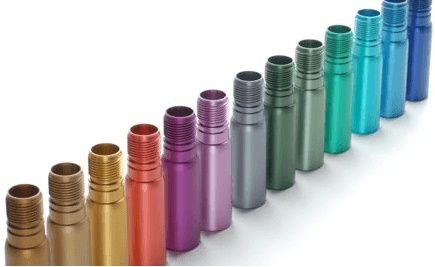You should understand the limitations of different processes, the surface treatment of aluminum alloys is usually anodized and not suitable for electroplating. The common surface treatment of zinc alloy die casting is electroplating, which is not suitable for anodizing. Aluminum alloy die castings are also not suitable for anodizing, and the effect of anodizing is relatively poor, and those with high appearance requirements should be used with caution. Usually, the surface treatment of metal alloys is electroplating or anodizing. What is the difference between these two processes?

The Difference between Electroplating and Anodizing
The difference between electroplating and anodizing lies in different treatment methods, different treatment objects and different treatment principles.
1. Different Treatment Methods
Electroplating is to use the material to be plated as the cathode, the same metal material as the coating metal as the anode (insoluble anode is also used), and the electrolyte is a solution containing the metal ions of the coating; a certain current is input between the anode and the cathode. The coating material and the material to be electroplated are two different materials, such as beryllium copper nickel plating, beryllium copper as the base material, and nickel as the plating layer.
Anodizing uses chemical or electrochemical treatment to form a film layer containing the metal component on the metal surface. The material to be treated is used as an anode, and is protected by a material that forms a film layer on its surface through an external current in a specific electrolyte. For example, the oxidation of aluminum alloy is to form a layer of aluminum oxide film on the surface of aluminum alloy.
2. Different Processing Objects
The objects processed by the electroplating method are mainly metals, but also non-metals. The most commonly used electroplating metals are nickel, chromium, tin, copper, silver and gold. That is to say, nickel-plated, chrome-plated, gold-plated and so on.
Anodizing is a method of metal surface treatment. Most metal materials (such as stainless steel, zinc alloy, aluminum alloy, magnesium alloy, copper alloy, titanium alloy) can be anodized in a suitable electrolyte.
3. The Processing Principle
Electroplating is the electroplating material as the cathode and the anodized tape treatment material as the anode. Electroplating is due to the charge effect, the metal anode ions move to the cathode, and get electrons at the cathode and deposit on the material to be plated. At the same time, the metal of the anode dissolves, and the metal ions in the electrolyte are continuously replenished.
First, the electroplating solution has six elements: main salt, additional salt, complexing agent, buffer, anode activator and additives. The electroplating principle includes four aspects: electroplating solution, electroplating reaction, electrode and reaction principle, and metal electrodeposition process.
Anodizing is the use of aluminum alloy’s easy oxidation characteristics to control the formation of oxide layer by electrochemical method to prevent further oxidation of aluminum material and increase the mechanical properties of the surface. Generally speaking, the anode is made of aluminum or aluminum alloy as the anode, and the cathode is selected from the lead plate, and the aluminum and lead plate are placed in an aqueous solution, which contains sulfuric acid, oxalic acid, chromic acid, etc. An oxide film is formed on the surface. Of these acids, the most widespread is anodizing with sulfuric acid. Aluminum alloy anodization technology is currently the most widely used and most successful. Aluminum alloy anodization can greatly improve the surface hardness, wear resistance and other indicators. There are a lot of micropores in the thin oxide film layer, which can adsorb various lubricants, suitable for the manufacture of engine cylinders or other wear-resistant parts; the film micropores have strong adsorption capacity and can be colored into various beautiful and bright colors. Non-ferrous metals or their alloys (such as aluminum, magnesium and their alloys) can be anodized. This method is widely used in mechanical parts, aircraft and auto parts, precision instruments and radio equipment, daily necessities and architectural decoration.
Why Is Aluminum Alloy Not Suitable for Electroplating
The chemical properties of aluminum are relatively active. If electroplating, in the acidic electrolyte, the aluminum ions on the cathode will generate aluminum salts and hydrogen while obtaining electron reduction. In the case of an alkaline electrolyte, aluminum hydroxide and hydrogen are generated. Therefore, aluminum cannot be plated by electroplating. This is the same reason that the electrolysis of salt water does not get metal sodium, but sodium hydroxide.
Die-Cast Aluminum Alloy Has Poor Oxidation Surface Effect
Cast aluminum alloys and die castings generally contain high silicon content, and the anodic oxide film is dark, and it is impossible to obtain a colorless and transparent oxide film. Dark grey to black grey. Therefore, cast aluminum alloys are not suitable for anodizing. However, the effect of anodizing treatment of zinc alloy die castings will be particularly poor, the yield rate is very low, and anodizing treatment is also a very cumbersome process. Zinc alloy die castings are usually surface treated by electroplating.